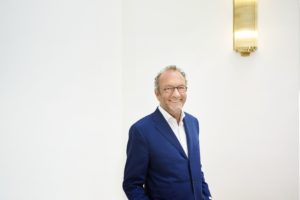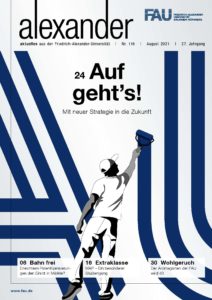Looking towards the future
Modernizing FAU’s Corporate Design
FAU is developing a new strategy for the future. We will be presenting the elements of this strategy in the next few issues. The first area we would like to look at is culture and the updated corporate design of FAU. We talked to FAU President Prof. Dr. Joachim Hornegger and international brand developer Claus Koch.
FAU’s strategy for the future was recently presented to the FAU community. What aims is the University pursuing with its strategy for the future?
Prof. Hornegger: The University has been undergoing a strategic development process for a while now. It began in 2013 with the faculty evaluations. In 2017, we devised a new communication format with our FAU Strategy Talks, and in 2018 we introduced our new fields of action People, Education, Research and Outreach, reorganising the Vice Presidents’ areas of responsibility accordingly. We set priorities: Attracting new talent, onboarding, appointment strategies, and funding and support for teaching and research. Now the time has come to focus on FAU’s strategic development. We have identified various categories and targets for this purpose. The FAU brand, how we see ourselves and internal and external communication are consolidated under the area of ‘culture’. #FAU2025 reformulates the very specific medium-term goals of our strategy process and includes the strategic fields of action that also encompass topics of relevance across the university such as equality, internationalisation, digitalisation and sustainability. When implementing our goals, we can rely on resources on the Bavarian State level, Federal level and European level. The category ‘structure’ gives our strategy a strong foundation. This aspect involves developing infrastructure and administration, for example the Hightech Campus, transport routes or networking structures. It is therefore important to address which intermediary goals we would like to achieve during which steps. These goals must be summarised and communicated using language and designs that enable everyone to see, feel and understand that we are evolving.
Our goal is to make FAU ready for the future, not only in terms of the competition in the Excellence Strategy, but also in terms of competition for top national and international researchers as well as excellent students so that we can maintain our position as a highly-innovative university.
Culture is a very important part of building our strategy for the future. Why?
Prof. Hornegger: We deliberately prioritised culture before #FAU2025 and structure as culture is ultimately the most decisive factor for the success of an organisation. Even the best strategic reorganisation cannot easily be implemented if the relevant culture does not exist at the university. This area includes dealing with the FAU brand and its image. How well liked is the University, not only by its members and guests, but also by people in Erlangen and Nuremberg, in Bavaria, Germany and beyond? We are developing an appropriate communication culture for this purpose both within and outside the University in which exchanging information and ideas is a matter of course. We want to make it perfectly clear what we stand for, what our key values are, and which path we want to take as a University over the next five years. It is therefore also very important that we develop a community at FAU in which each and every one of us takes on some responsibility and knows exactly which contribution we can make to the future of FAU.
Mr Koch, you were responsible for the new corporate design at FAU. You have not only developed brand strategies and designs for several prestigious companies, but also for universities. What makes FAU stand out?

Claus Koch: The main difference is that with companies, at the end of the day it is the CEO who makes the decision, and everyone else supports this decision. This is also the difference between state universities and private universities, where the president and university council of the foundation make the decisions. At state universities, on the other hand, decisions are influenced by a wide range of opinions and varying perspectives, all of which are perfectly justified, irrespective of which faculty they come from. We want to provide a platform that offers enough freedom for innovative thinking. We should not place ourselves above the opinions of others, but rather include these opinions in our work, which is what we have done.
FAU’s motto ‘Moving knowledge’ is leading the University into the future. What’s behind this idea?
Prof. Hornegger: It’s important for us that we take care when developing our motto and don’t lose sight of our own history. Claus Koch held many interviews with members of the Senate, the Executive Board, and the faculties as well as with students and people from outside the University. Among other topics, he discussed our previous motto ‘Knowledge in motion’. Even though many people said that the motto is appropriate and reflects what we do at FAU, others said that it is a bit too static. ‘Moving knowledge’, on the other hand, is more dynamic and gives direction. We can work with it and play around with it – moving knowledge, moving innovation. Moving FAU. ‘Moving knowledge’ describes what we do at FAU. We develop knowledge, pass it on to others, we generate and combine knowledge. These are all important factors that play to FAU’s strength.
Claus Koch: We are suddenly in an active role, we are moving knowledge. Previously, knowledge was in motion but now you are moving it. This is the greatest and most important difference. I would also like to emphasise, though, that we won’t be changing things overnight. Don’t expect everything to suddenly be different, with all previous achievements thrown out of the window. That would contradict our own objectives in terms of sustainability. FAU is a state university with a great deal of responsibility. This is why we’re talking about further development in the sense that we’re reinterpreting the past, but we are aware that we don’t have to start from scratch.
Moving FAU. This statement is based on FAU’s vision, mission, values and strengths. What do they stand for?
Prof. Hornegger: These terms are more than just slogans for the FAU brand. Their aim is to define FAU. Our vision involves creating a platform that offers freedom for innovative thinking: in studying, research, teaching and cooperation. We make this possible by focusing on our strengths with curiosity, determination, sustainability, respect and openness as well as on our values of innovation, diversity and passion. These strengths and values enable us to get to the core of the most important and exciting questions and issues we face, both today and in the future. We foster talent and shape individuals, promote a culture of collaboration within the University and externally and are always on a par with the competition. We therefore make an important contribution to education, knowledge, exchanging ideas and to values in society as a whole. This is our mission. Together we must thus ensure that FAU remains a place with enough freedom for the members of the FAU community to discover and develop new ideas with courage, creativity and their own intrinsic motivation, to pass on their knowledge and make sure that FAU remains an innovator in the future.
The visual component of this message must not be underestimated. How did the vision, mission, values and strengths of FAU influence its new corporate image?
Claus Koch: They formed the basis for its development. FAU is driven by knowledge and content and we had to ensure that the visual elements also reflected this content. We changed a purely technical logo into one that incorporated this idea. The three lines in the new logo have a profile that show a change in perspective, openness, networking and dynamism. These elements are what’s behind the vision, mission, values and strengths of FAU. As for the seal, we decided on a design that is closer to that of the original version from 1832, but of course we changed quite a few things and decided to add the year the University was founded. Here too, we reinterpreted the past and are leading it into the future. This is our goal.
When things change, people first have to get used to them, regardless of whether it’s a new logo or new structures. How are you going to win over the FAU family in this respect?
Prof. Hornegger: That’s a very important point. We must never forget that people react to change, often in the form of criticism. We can only face up to this criticism if we show we are open to discussion and start communicating early in the process. I think it was very important that we first talked to representatives from the various groups of stakeholders, before informing the selected committees individually and informing everyone else via the FAU Strategy Talk. We invite all members of FAU to these FAU Strategy Talks as we hope to encourage everyone to participate in the discussion about the future of our University. We offer everyone the opportunity every month to get in touch directly with the Executive Board, to ask critical questions and voice their own opinions.
Claus Koch: I can only agree with Prof. Hornegger here. In addition, we will publish a small brand book that will allow everyone to become an FAU ambassador. Companies and institutions often announce changes such as this outside their organisation before communicating them internally. I feel it’s important that everyone within FAU understands why these changes have been made as this is the only way we can communicate them appropriately outside the University.
From Boris Mijat

Die Themen der neuen Ausgabe sind: ein Interview mit dem Präsidenten der FAU, Prof. Dr. Joachim Hornegger, und dem Markendesigner Claus Koch über die neue Zukunftsstrategie der FAU, eine Untersuchung über den Einfluss von Patenten auf Marktentwicklungen, die Studiengänge „Advanced Materials and Processes“ und „Clean Energy Processes“, ein Spaziergang durch unseren Aromagarten, der heuer sein 40. Jubiläum hat, und ein Interview mit dem Siemens-CEO Dr. Roland Busch.
alexander online lesen oder kostenlos bestellen